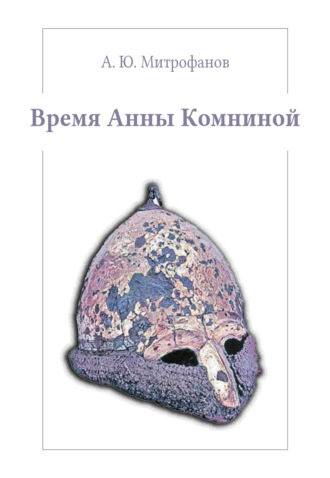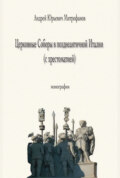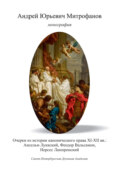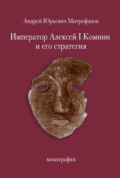
Андрей Юрьевич Митрофанов
Время Анны Комниной
© Издательство Санкт-Петербургской Духовной Академии, 2021
О книге
Новая книга доктора исторических наук Андрея Юрьевича Митрофанова «Время Анны Комниной» посвящена отражению царствования императора Алексея I (1081–1118) и его эпохи в «Алексиаде» – главном сочинении его дочери, принцессы Анны Комниной (1083–1153/1154). По словам выдающегося византиниста и историка искусства Ганса Белтинга, император Алексей I изображен принцессой Анной как «живая икона» (als lebende Ikone)[1]. Однако, по мнению А. Ю. Митрофанова, несмотря на желание Анны написать хвалебную биографию отца, «Алексиада» в действительности выходит за жанровые рамки панегирика и оказывается зеркалом эпохи, судьбы которой во многом определяли царствование Алексея I.
Принцесса Анна писала «Алексиаду» спустя тридцать лет после смерти отца и неудачной попытки дворцового переворота – которая привела ее к почетной ссылке в монастырь Пресвятой Богородицы Благодатной «Кехаритомени», – в бурную эпоху царствования своего племянника императора Мануила I Комнина (1143–1180), пытавшегося ценой неимоверных усилий вновь превратить Византийскую империю в военного и политического гегемона, каковым она была в эпоху императоров Юстиниана I Великого (527–565) и Василия II Болгаробойцы (976–1025).
«Алексиада», написанная Анной Комниной примерно в 1146–1148 годах, стала, как полагает А. Ю. Митрофанов, своеобразным политическим завещанием августейшему племяннику и, в тоже время, оппозиционным манифестом, направленным против его пролатинской политики. Именно сочетание биографии, исторической хроники и актуального политического памфлета сделали «Алексиаду» той книгой, которую Карл Крумбахер назвал «лучшим историческим произведением, которое оставило нам средневековье»[2]. Любопытно, что некоторые придворные интриги, описанные принцессой Анной – к примеру, романтические отношения императрицы Марии Аланской и Алексея Комнина, – находят, как показывает А. Ю. Митрофанов, параллели в творчестве сельджукского поэта Фахраддина Гургани (XI век), писавшего на персидском языке и опиравшегося на утраченный парфянский рыцарский роман[3].
Принцесса Анна, будучи мемуаристом, не только создала галерею портретов выдающихся представителей византийских императорских династий – таких, как ее отец император Алексей Комнин, мать императрица Ирина Дукена, бабушка Анна Далассина, нареченная теща императрица Мария Аланская, – но и, будучи историком, обозначила целый ряд этнографических и политических проблем, с которыми столкнулась Византийская империя на исходе XI века. Одной из них было создание державы Великих Сельджукидов, завоевавших под бунчуком султанов Тогрул-бека (1038–1063), Алп-Арслана (1063–1072) и Малик шаха (1072–1092) Хорасан, Иран и огромные пространства от Средиземного моря до Кашгарии, от Кавказа до Йемена. Интересно, что императора Алексея Комнина – который уже пользовался помощью сельджуков во время войны против Русселя де Байоля, мятежного норманнского рыцаря – распри между великим султаном Малик Шахом и анатолийскими сельджуками подтолкнули к союзу с Малик Шахом.
В книге А. Ю. Митрофанов по-новому ставит вопрос о возможном монгольском происхождении династии великих Сельджукидов в свете военно-политического влияния в Туркестане киданьской империи Ляо, приводя аргументы в пользу данного предположения. Одним из них является тезис автора – опирающийся, в частности, на мнение археолога, этнографа и художника М. В. Горелика – о характерном для советского востоковедения сознательном игнорировании роли монгольского фактора в истории Средней Азии. Другой аргумент – оригинальное предположение о наличии литературного влияния «Шахнаме» Абулькасима Фирдоуси на историю Сельджука из «Малик-наме», сельджукского эпоса XI–XII вв., сохранившегося в отрывках благодаря сочинению Мирхонда и некоторых других поздних восточных историков. Автор ссылается также на работы Г. В. Вернадского, отмечавшего распространение у ряда монгольских племен в XI–XII вв. христианства несторианского толка, и сопоставляет это явление с гипотезой о христианском исповедании некоторых сыновей Сельджука, в частности, Микаила.
Не менее подробно А. Ю. Митрофанов исследует фрагменты «Алексиады», посвященные феномену византийского самозванчества, одним из первых примеров которого стало появление в конце царствования императора Льва III Исавра (717–741) самозванца Лже-Тиберия Пергамена, объявившего себя выжившим сыном императора Юстиниана II Ринотмета (685–695 – 705–711), в действительности убитого в 711 году на глазах бабушки, императрицы Анастасии. Опираясь на исследования Пауля Шпека и др.[4], А. Ю. Митрофанов предполагает, что рассказ гипотетического «Жизнеописания Льва» (*Vita Leonis) об убийстве Тиберия, воспроизведенный в «Хронографии» Феофана Исповедника, для большей убедительности мог подвергнуться интерполяциям в период мятежа Лже-Тиберия Пергамена. По свидетельству источников для «досье» Георгия Синкелла – например, гипотетической «Истории Льва и Константина» (*HL), которым следовал Феофан Исповедник в изложении событий византийской истории после 718 года, – Лже-Тиберий Пергамен получил поддержку омейядского халифа Хишама ибн Абдул-Малика (723–743)[5].
Подобная опора на внешних врагов Византийской империи была характерна и для последующих византийских самозванцев, современником которых была принцесса Анна. А. Ю. Митрофанов подробно исследует ее рассказы о Лже-Михаиле и Лже-Диогене I, а также упоминает о мятеже Лже-Диогена II – Девгеневича русских летописей, и его сына лжецаревича Василько Леоновича. Лже-Михаил был ставленником норманнов и лично Роберта Гвискара, Лже-Диоген I опирался на помощь половецкого хана Тугоркана, Девгеневич и лжецаревич Василько пользовались поддержкой и официальным признанием киевского великого князя Владимира Мономаха (1113–1125), который породнился с самозванцем, выдав за Девгеневича свою дочь Марицу, сыном которой и стал лжецаревич Василько.
По мнению А. Ю. Митрофанова, феномен византийского самозванчества, описанный принцессой Анной и другими византийскими историками, был воспринят русской политической культурой, что проявилось спустя много веков в период Смутного времени (1605–1613), затем – в царствование императрицы Екатерины Великой (1762–1796), после чего – оказав влияние на формирование феномена вождей и тоталитаризма в СССР.
Автор подробно исследует состояние описанных принцессой Анной вооруженных сил Византийской империи и норманнов, и приходит к выводу о вестернизации византийской военной аристократии в эпоху императора Алексея Комнина. При этом мнения ряда исследователей, утверждающих, что принцесса Анна не была автором оригинального сочинения, а лишь литературно обработала записки своего мужа Никифора Вриенния, хорошо разбиравшегося в военном деле, подвергнуты критике. Анна Комнина, по мнению А. Ю. Митрофанова, вела самостоятельную исследовательскую работу и имела доступ не только к запискам Никифора Вриенния или показаниям епископа Бари – о чем писал Я. Н. Любарский, – но также к несохранившимся воспоминаниям Георгия Палеолога и Татикия.
Книга А. Ю. Митрофанова «Время Анны Комниной» – отнюдь не сухая научная монография, но исследование, написанное живым литературным языком, и этим она выгодно отличается от многих современных публикаций по истории Византии. Можно даже утверждать, что автор книги стремится подражать своей главной героине – принцессе Анне Комниной.
Один мудрец как-то сказал, что Бог определяет долготу человеческой жизни, а широту жизни определяет сам человек. Судьба Анны Комниной в полной мере подтверждает эти слова, ибо августейшая принцесса сумела вместить в своей творческой жизни целую эпоху византийской истории…
Summary
The book “The Time of Anna Komnena” by A. Yu. Mitrofanov is devoted to the reflection of the reign of Emperor Alexios I (1081–1118) and his era in the main work of his daughter, Princess Anna Komnena (1083–1153/1154), which is known as the “Alexiad”. As noted by the prominent Byzantintinist and Art Historian Hans Belting, Emperor Alexios I was depicted by Anna Komnena as a “living icon” (als lebende Ikone)[6]. However, A. Yu. Mitrofanov proves that despite the desire of Anna Komnena to write a laudatory biography of her father, in reality, the “Alexiad” far exceeded the genre framework of the panegyric and became a mirror of the era, the fate of which largely determined the reign of Emperor Alexios I. Anna Komnena wrote the “Alexiad” thirty years after the death of her father and the unsuccessful attempt at a palace coup, which led Anna Komnena to an honorable exile in the monastery of the Most Holy Theotokos of Grace “Kecharitomene”. There the princess wrote the Alexiad during the turbulent reign of her nephew, Emperor Manuel I Komnenos (1143–1180), who, at the cost of incredible efforts, tried to retransform the Byzantine Empire into a military and political hegemon, as the Byzantine Empire was in the era of Emperor Justinian I the Great (527–565) and Emperor Basil II the Bulgar Slayer (976–1025). According to A. Yu. Mitrofanov, the “Alexiad”, written by Anna Komnena around 1146–1148, was a kind of political testament to her nephew of the imperial family and at the same time an opposition manifesto, which had been directed against his pro-Latin policy. According to A. Yu. Mitrofanov, it was the combination of a biography, of a historical chronicle and of a current political manifesto, which made Anna Komnena’s “Alexiad” the book that Karl Krumbacher rightly called “the best historical work that the Middle Ages left us»[7]. As A. Yu. Mitrofanov notes, some of the court intrigues described by Anna Komnena, in particular, the romantic relationship of the Empress Maria of Alania and Alexios Komnenos, find parallels in the work of the Seljuk poet Fakhruddin Gurgani (XIth century), who wrote in Persian and, according to V. F. Minorsky, relied on the lost Parthian knight’s novel[8].
As A. Yu. Mitrofanov shows, Anna Komnena, being a memoirist, not only created a gallery of portraits of prominent representatives of the Byzantine imperial dynasties, such as her father – Emperor Alexios Komnenos, her mother – Empress Irina Dukena, her grandmother – Anna Dalassena, the mother of her fiancé, her mother in-Law – Empress Maria of Alania, but, she, being a historian, outlined a number of ethnographic and political problems, which were faced by the Byzantine Empire at the end of the XIth century. One of these problems was the arise of the power of the Great Seljuks, who conquered under the standard (Bunchuk) of the sultans Togrul-bey (1038–1063), Alp-Arslan (1063–1072) and Malik Shah (1072–1092) Khorasan, Iran and vast areas from the Mediterranean Sea to Kashgaria, from the Caucasus to Yemen. Although the result of the Seljuk conquests was the appearance of the Seljuks in Byzantine Asia Minor and the rapid conquest of the peninsula, however, the feuds between the great Sultan Malik Shah and the Anatolian Seljuks pushed the Emperor Alexios Komnenos into an alliance with Malik Shah against the Sultanate of Rumia. Moreover, Alexios Komnenos had already used the help of the Seljuks during the war against Roussel de Bailleul – a rebellious Norman knight who tried to create his own principality on the territories of the ancient Byzantine “Armeniac” Theme in 1074.
A. Yu. Mitrofanov raises the question of the possible Mongolian origin of the Great Seljuk dynasty in the light of the military and political influence of the Khitan Liao Empire in Turkestan in a new way and gives interesting arguments in favor of this assumption. One of these arguments is the author’s thesis about the deliberate ignoring of the role of the Mongolian factor in the history of Central Asia, an ignoring which is characteristic of Soviet Oriental studies. This thesis of the author particularly is based on the opinion of the excellent archaeologist, ethnographer and artist M. V. Gorelik. Another argument of A. Yu. Mitrofanov is the original assumption that there is a literary influence of the Abulqasem Ferdowsi’s “Shahnameh” on the history of Seljuk from the “Malik-nameh” – a Seljuk epic of the XIth–XIIth centuries, which has been preserved in fragments thanks to the work of Mirkhond and some other late Eastern historians. For this remarkable discovery A. Yu. Mitrofanov also refers to the works of G. V. Vernadsky, who noted the spread of the Christianity among some Mongolian tribes in the XIth–XIIth centuries. The author A. Yu. Mitrofanov compares this phenomenon of the Christianity among some Mongolian tribes with the hypothesis of the Christian confession of some of the Seljuk’s sons, in particular, Mikail.
Furthermore A. Yu. Mitrofanov also examines in detail the fragments of the work of Anna Komnena, which were dedicated to the phenomenon of so called Byzantine imposture. According to A. Yu. Mitrofanov, one of the first examples of Byzantine imposture arrived at the end of the reign of Emperor Leo III the Isaurian (717–741) with the appearance of the impostor Pseudo-Tiberius Pergamenus, who declared himself the surviving son of Emperor Justinian II Rhinotmetos (685–695, 705–711). The name of Justinian’s II son was Tiberius and he has been murdered as a child of eleven years old in 711 in front of his grandmother – Empress Anastasia. Drawing on the research of Paul Speck and others[9], A. Yu. Mitrofanov suggests that the hypothetical story of the “Life of Leo” (*Vita Leonis) about the murder of Tiberius, which had been reproduced in the “Chronography” of Theophanes the Confessor, probably has been interpolated during the rebellion of Pseudo-Tiberius Pergamenus to uncover him.
According to sources of the “dossier” of George Synkellos, one of them is, for example, a hypothetical “History of Leo and Constantine” (*HL), which had been followed by Theophanes the Confessor in the narrative of Byzantine history after the year 718, Pseudo-Tiberius Pergamenus received the support of the Umayyad Caliph Hisham Ibn Abdal-Malik (723–743)[10]. Such reliance on external enemies of the Byzantine Empire was characteristic of later Byzantine impostors, to whom Anna Komnena was contemporary. That is why Mitrofanov examines in detail the fragments of Anna Komnena on the impostors Pseudo-Michael and Pseudo-Diogenes I Furthermore the Author mentions out of the Russian Chronicles the rebellion of the impostor Pseudo-Diogenes II “Devgenevich” and the rebellion of his son, the Pseudo-Prince Vasilko Leonovich.
Pseudo-Michael was a protégé of the Normans and Robert Guiscard personally; Pseudo-Diogenes I relied on the help of the Cuman Khan Tugorkan, while Devgenevich and Pseudo-Prince Vasilko enjoyed the support and official recognition of the Grand Duke of Kiev Vladimir Monomakh (1113–1125).
Vladimir Monomakh even related himself to the impostor Devgenevich by marring his daughter Maritsa to him. Their son was the impostor Pseudo-Prince Vasilko. On the basis of these undeniable historical facts, proved by A. Yu. Mitrofanov, the phenomenon of Byzantine imposture, which had been largely documented and described by Anna Komnena and other Byzantine historians, mentioned by the Author, proves to be an old and well known strategy of impostors on the byzantine imperial throne. This phenomenon is repeated by Russian political culture. This circumstance manifested itself many centuries later during the Time of Troubles (1605-1613) and during the reign of Empress Catherine the Great (1762–1796), and then influenced the formation of the phenomenon of Soviet leaders and Soviet totalitarianism.
A. Yu. Mitrofanov explores in detail the state of the armed forces of the Byzantine Empire and the Normans who were extensively documented by Anna Komnena, and he comes to the conclusion about the Westernization of the Byzantine military aristocracy in the era of the Emperor Alexios Komnenos. A. Y. Mitrofanov criticizes the views of some researchers who claim that Anna Komnena was not an author of an original work, but only treated the notes of her husband, Nikephoros Bryennios, who was well versed in military Affairs.
That is why A. Yu. Mitrofanov examines those notes of Nikephoros Bryennios. His investigations of these notes are proving, that Anna Komnena conducted her own independent research work and had access not only to the notes of Nikephoros Bryennios or the testimonies of the Bishop of Bari, as wrote Ya. N. Lyubarsky, but also to the lost memoirs of George Palaiologos and Tatikios.
The book of A. Yu. Mitrofanov “The Time of Anna Komnena” is not a dry scientific monograph, but a work, which is written in a living literary language. This book of A. Yu. Mitrofanov compares favorably with many modern publications on the history of Byzantium. From this point of view, it seems obvious that A. Yu. Mitrofanov seeks to imitate his main heroine – Anna Komnena.
One philosophe once said, God determines the longitude of the human life, but the latitude of the life is determined by the human person himself. Anna Komnena fully confirms these words, for the Porphyrogenita princess of the imperial byzantine family managed to accommodate an entire epoch of Byzantine history in her creative life…
Résumé
Le livre d’A. Yu. Mitrofanov «Le Temps d’Anne Comnène» est dédié à la réflexion sur le règne de l’empereur Alexis Ier (1081–1118) et sur son époque dans l’œuvre principale de sa fille, la princesse Anne Comnène (1083–1153/1154), connue sous le nom de l’«Alexiade». Comme l’a mentionné un byzantiniste éminent et historien de l’art Hans Belting, l’empereur Alexis Ier a été représenté par Anna Comnène comme une «icône vivante» (als lebende Ikone)[11]. Cependant, A. Yu. Mitrofanov prouve que malgré le désir d’Anna Comnène d’écrire une biographie élogieuse de son père, en réalité, l’«Alexiade» a largement dépassé le cadre de genre du panégyrique et elle est devenu un miroir de l’époque, dont le sort a largement déterminé le règne de l’empereur Alexis Ier. Anna Comnène a écrit l’«Alexiade» trente ans après la mort de son père et de la tentative infructueuse d’un coup d’état du palais, qui a conduit Anna Comnène à l’exil honorable dans le monastère de la Très Sainte Théotokos de Grâce «Kecharitomene». La princesse a écrit l’«Alexiade» pendant le règne turbulent de son neveu, l’empereur Manuel Ier Comnène (1143–1180), qui a essayé de transformer l’Empire Byzantin dans un hégémon militaire et politique, comme l’était l’Empire Byzantin à l’époque de l’empereur Justinien Ier le Grand (527–565) et de l’empereur Basile II le Bulgaroctone (976–1025), au prix d’efforts incroyables. D’après A. Yu. Mitrofanov l‘«Alexiade», écrite par Anne Comnène vers 1146–1148, était une sorte de testament politique à son neveu auguste et en même temps un manifeste d’opposition, qui était dirigé contre sa politique pro-latine. D’après A. Yu. Mitrofanov c’est la combinaison de biographie, de chronique historique et de manifeste politique actuel qui a fait l’«Alexiade» d’Anne Comnène le livre que Karl Krumbacher a appelé à juste titre «le meilleur travail historique que le Moyen Âge nous a laissé»[12]. Comme A. Yu. Mitrofanov mentionne, les certaines des intrigues de la cour, décrites par Anne Comnène, en particulier les relations amoureuses de l’impératrice Maria d’Alania et Alexis Comnène, trouvent des parallèles dans l’ouvrage du poète seldjoukide Fakhruddin Gurgani (XIme siècle), qui a écrit en persan, et d’après l’opinion de V. F. Minorsky qui s’est appuyé sur le roman chevaleresque parthe perdu[13].
Comme A. Yu. Mitrofanov montre, Anne Comnène, en tant que mémorialiste et contemporaine, a créé non seulement une galerie des portraits des représentants éminents des dynasties impériales byzantines, tels que son père – l’empereur Alexis Comnène, sa mère – l’impératrice Irene Dukena, sa grandmère – Anna Dalassena, sa belle-mère fiancée – l’impératrice Maria d’Alania, mais, en tant qu’historienne, elle a décrit un certain nombre des problèmes ethnographiques et politiques, avec lesquels l’Empire Byzantin a été confronté à la fin du XIme siècle. L’un de ces problèmes a été la naissance du pouvoir des Grands Seldjoukides, qui ont conquis sous l’étenard («Bunchuk») des sultans Togrul-bey (1038–1063), Alp-Arslan (1063–1072) et Malik Shah (1072–1092) Khorasan, l’Iran et les vastes zones de la Méditerranée à Kashgaria, du Caucase au Yémen. Bien que le résultat des conquêtes des Seldjoukides ait été l’apparence des Seldjoukides dans l’Asie Mineure Byzantine et la conquête rapide de la péninsule, cependant, les querelles entre le Grand Sultan Malik Shah et les Seldjoukides anatoliens ont poussé l’empereur Alexis Comnène vers l’alliance avec Malik Shah contre le Sultanat de Rumia. De plus, Alexis Comnène avait déjà utilisé l’aide des Seldjoukides pendant la guerre contre Roussel de Bailleul – un chevalier normand rebelle qui avait essayé de créer sa propre principauté sur les territoires de l’ancien thème byzantin «Arméniaques» en 1074.
A. Yu. Mitrofanov soulève la question de l’origine mongole éventuelle de la grande dynastie seldjoukide à la lumière de l’influence militaire et politique de l’Empire Khitan Liao au Turkestan d’une manière nouvelle et il donne des arguments intéressants en faveur de cette hypothèse. L’un de ces arguments est l’ignorance délibérée du rôle du facteur mongol dans l’histoire de l’Asie Centrale, une ignorance, qui est caractéristique pour les études orientales soviétiques. Cet argument de l’auteur, en particulier, est basée sur l’opinion de l’archéologue excellent, l’ethnographe et l’artiste M. V. Gorelik. Un autre argument d’A. Yu. Mitrofanov est l’hypothèse originale, d’après laquelle il y a une influence littéraire du “Shahnameh” d’Abulqasim Ferdowsi sur l’histoire de Seldjouk, présentée dans le “Malik-nameh” – une épopée seldjoukide des XIme–XIIme siècles, qui est conservée en fragments grâce au travail de Mirkhond et des autres historiens orientaux tardifs. Dans le cadre de cette découverte remarquable A. Yu. Mitrofanov se réfère également aux travaux de G. V. Vernadsky, qui a noté la propagation du christianisme parmi certaines tribus mongoles aux XIme–XIIme siècles. L’auteur compare ce phénomène de la propagation du christianisme parmi les certaines tribus mongoles à l’hypothèse de la confession chrétienne des certains fils de Seldjouk, en particulier Mikail.
Outrement A. Yu. Mitrofanov examine en détail également les fragments de l’œuvre d’Anne Comnène, consacrés au phénomène de la soi-disante imposture byzantine. D’après A. Yu. Mitrofanov l’un des premiers exemples de l’imposture byzantine se manifesta à la fin du règne de l’empereur Léon III l’Isaurien (717–741) avec l’apparition de l’imposteur Pseudo-Tibère Pergamenos, qui s’est déclaré le fils survivant de l’empereur Justinien II Rhinotmétos (685–695, 705–711). Ce fils de Justinian II s’appelait Tiberius et a été assasiné dans son enfance à l’âge de onze ans en 711 devant les yeux de sa grand – mère – l’impératrice Anastasia. En s’appuyant sur les recherches de Paul Speck et des autres chercheurs[14], A. Yu. Mitrofanov suggère que le récit de la source hypothétique la «Vie de Léon» (*Vita Leonis) sur l’assassinat de Tibère, qui avait été réproduit dans la «Chronographie» de Théophane le Confesseur aurait pu être interpolée pendant la rébellion du Pseudo-Tibère Pergamenos pour le démasquer.
D’après les sources du «dossier» de Georges Synkellos, par exemple d’une hypothétique «Histoire de Léon «(*HL), qui était suivie par Théophane le Confesseur dans le récit de l’histoire byzantine après l’année 718, le Pseudo-Tibère Pergamenos a reçu le soutien du Calife Omeyyade Hisham Ibn Abdal-Malik (723–743)[15]. Cette dépendance des ennemis extérieurs de l’Empire Byzantin était caractéristique des imposteurs byzantins ultérieurs, dont Anne Comnène était contemporaine.
C’est pourquoi A. Yu. Mitrofanov examine outrement en détail les fragments d’Anne Comnène sur le Pseudo-Michel et le Pseudo-Diogène I, et il mentionne la rébellion du Pseudo-Diogène II ou le «Devgenevich» des chroniques russes et de son fils le Pseudo-Prince Vasilko Leonovich. Si le Pseudo-Michel était un protégé des normands et de Robert Guiscard personnellement, le Pseudo-Diogène I comptait sur l’aide du Khan des Cumans Tugorkan, tandis que le «Devgenevich» et le Pseudo-Prince Vasilko se bénéficiaient du soutien et de la reconnaissance officielle du Grand-Duc de Kiev Vladimir Monomaque (1113–1125). Vladimir Monomaque est devenu même un apparenté à l’imposteur et il a épousé sa fille Maritsa à «Devgenevich», dont le fils était le Pseudo-Prince Vasilko. Sur la base de ces indéniables faits historiques, prouvés par A. Yu. Mitrofanov, le phénomène de l’imposture byzantine, qui avait été largement documenté et décrit par Anne Comnène et par des autres historiens byzantins mentionnés par l’auteur se manifeste comme une ancienne stratégie bien connue par les imposteurs du trône impérial de l’Empire Byzantin. Il se répète dans la culture politique russe. Cette circonstance s’est manifestée plusieurs siècles plus tard à l’époque des Troubles (1605–1613) et sous le règne de l’impératrice Catherine la Grande (1762–1796), et ensuite elle a influencé la formation du phénomène des chefs soviétiques et du totalitarisme soviétique.
A. Yu. Mitrofanov explore en détail l’état des forces militaires de l’Empire Byzantin et des normands, qui ont été largement décrites par Anne Comnène, et il arrive à la conclusion sur l’occidentalisation de l’aristocratie militaire byzantine à l’époque de l’empereur Alexis Comnène. A. Y. Mitrofanov critique les certains chercheurs qui affirment qu’Anne Comnène n’était pas l’auteur d’un travail original, mais qu’elle n’a élaboré que les notes de son mari, Nicéphoros Bryennios, qui connaissait bien les affaires militaires. C’est pourquoi A. Yu. Mitrofanov examine ces notes de l’époux d’Anne Comnène, Nicéphoros Bryennios. Grâce à ces recherches d’A. Yu. Mitrofanov il est évident qu’Anne Komnene avait fait des recherches indépendantes et qu’elle avait un accès non seulement aux notes de Nicéphoros Bryennios ou aux témoignages de l’évêque de Bari, comme l’a écrit Ya. N. Lyubarsky, mais aussi aux mémoires perdues de George Palaiologos et Tatikios.
Le Livre d’A. Yu. Mitrofanov «Le Temps d’Anne Comnène» n’est pas une sèche monographie scientifique, mais il est une oeuvre, qui est écrite dans une langue littéraire vivante. Ce livre d’A. Yu. Mitrofanov se compare favorablement aux nombreuses publications modernes sur l’histoire de Byzance. De ce point de vue, il nous semble évident qu’A. Yu. Mitrofanov cherche à imiter son héroïne principale – Anne Comnène.
Comme l’a dit une fois un philosophe, Dieu détermine la longitude de la vie humaine, mais la latitude de la vie s’est déterminée par la personne humaine elle-même. Anne Comnène confirme ces paroles pleinement, car la princesse porphyrogénète de la famille impériale byzantine a réussi à accueillir toute une époque de l’histoire byzantine dans sa vie créative…





